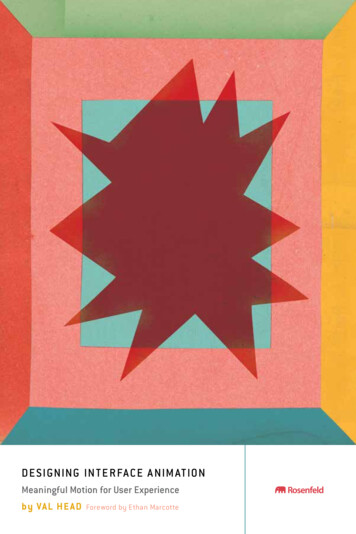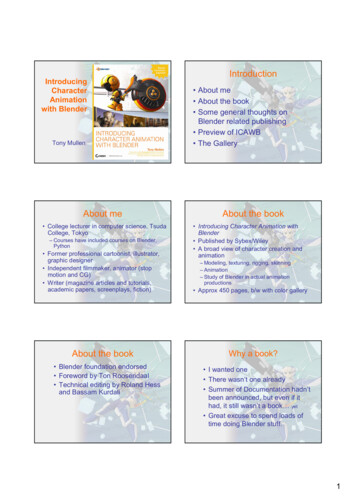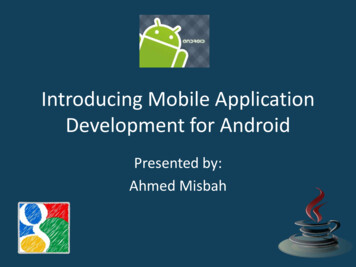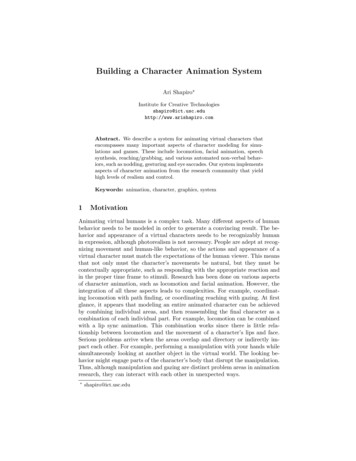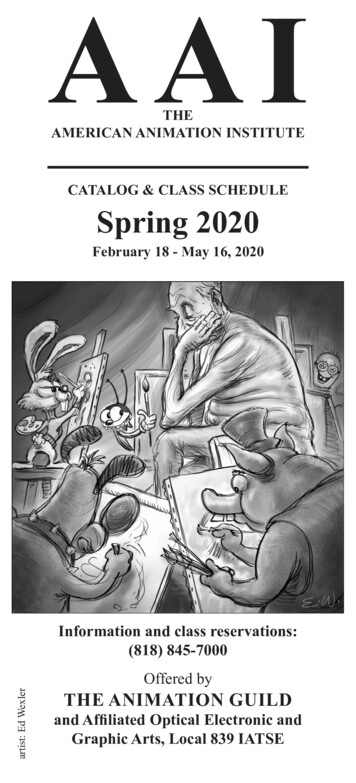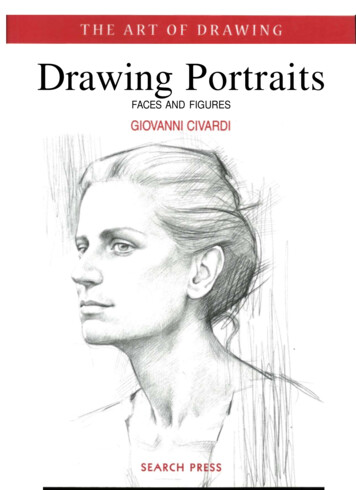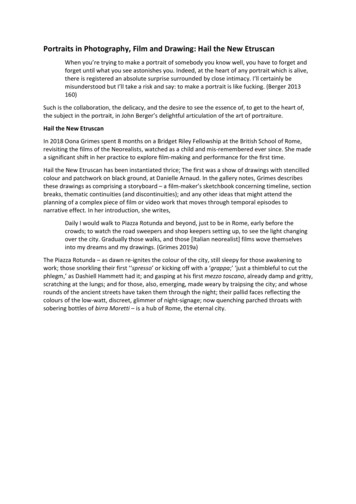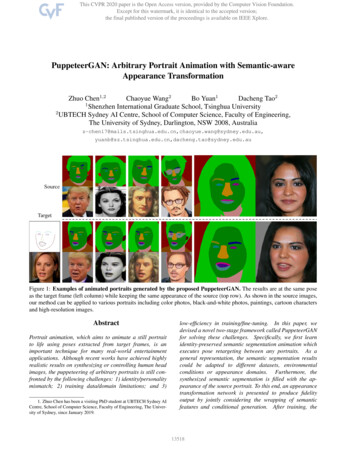
Transcription
PuppeteerGAN: Arbitrary Portrait Animation with Semantic-awareAppearance TransformationZhuo Chen1,2Chaoyue Wang2Bo Yuan1Dacheng Tao21Shenzhen International Graduate School, Tsinghua University2UBTECH Sydney AI Centre, School of Computer Science, Faculty of Engineering,The University of Sydney, Darlington, NSW 2008, tao@sydney.edu.auFigure 1: Examples of animated portraits generated by the proposed PuppeteerGAN. The results are at the same poseas the target frame (left column) while keeping the same appearance of the source (top row). As shown in the source images,our method can be applied to various portraits including color photos, black-and-white photos, paintings, cartoon charactersand high-resolution images.AbstractPortrait animation, which aims to animate a still portraitto life using poses extracted from target frames, is animportant technique for many real-world entertainmentapplications. Although recent works have achieved highlyrealistic results on synthesizing or controlling human headimages, the puppeteering of arbitrary portraits is still confronted by the following challenges: 1) identity/personalitymismatch; 2) training data/domain limitations; and 3)1. Zhuo Chen has been a visiting PhD student at UBTECH Sydney AICentre, School of Computer Science, Faculty of Engineering, The University of Sydney, since January 2019.low-efficiency in training/fine-tuning. In this paper, wedevised a novel two-stage framework called PuppeteerGANfor solving these challenges. Specifically, we first learnidentity-preserved semantic segmentation animation whichexecutes pose retargeting between any portraits. As ageneral representation, the semantic segmentation resultscould be adapted to different datasets, environmentalconditions or appearance domains. Furthermore, thesynthesized semantic segmentation is filled with the appearance of the source portrait. To this end, an appearancetransformation network is presented to produce fidelityoutput by jointly considering the wrapping of semanticfeatures and conditional generation. After training, the13518
two networks can directly perform end-to-end inferenceon unseen subjects without any retraining or fine-tuning.Extensive experiments on cross-identity/domain/resolutionsituations demonstrate the superiority of the proposedPuppetterGAN over existing portrait animation methods inboth generation quality and inference speed.1. IntroductionPortraits including paintings, photographs or other artistic representations of human beings have always been oneof the most important research objects in computer visionand graphics. In this work, we consider the task of portrait animation, which aims to animate a given portrait using poses provided by driven frames. This kind of techniquehas attracted great attention throughout the community because of its potentially wide usage in the film industry [7],art-making [47] and personalized media generation [35].In recent years, with the rapid development of deeplearning algorithms, some deep generative models are proposed for solving portrait animation tasks. Among them,one kind of solution is trained to decompose the disentangled appearance and pose representations from the inputportrait image [36, 25, 46]. Ideally, by recombining the appearance feature of the source portrait with the pose featureof the target frames, the generator/decoder is supposed togenerate the desired outputs. Though promising progresshas been made, the challenges remain on extracting the desired appearance and pose representations from unseen images (or videos) during inference.Facial landmarks, which can be conveniently detectedby recent techniques [38, 18, 31], are regarded as onekind of replacement of the disentangled pose representation.In [47, 33, 10], given the landmarks of the target frame asinput, the network is trained to reconstruct the target frameby conditioning on appearance information extracted fromother frames of the same video/person. Compare to directlydisentangling pose representations from images, methodsusing facial landmarks are more robust and usually with better generation results. However, during inference, it mayencounter a misalignment between the driven landmarksand the source portrait (e.g. different face shape), which willresult in poor results. In addition, considering the appearance representation may fail to be extracted from unseenportraits that following different distribution with trainingdata [4, 22], the few-shot fine-tuning strategy is employedto learn accurate appearance information [18, 45]. By utilizing a few images of the same person to fine-tune the pretrained model, these methods will achieve better results foreach specific identity. However, in real-world applications,the fine-tuning would cost much more time and computation resources than simply feed-forward inference.Therefore, although recent works have achieved con-vincing results on synthesizing or controlling portraits, weargue that the puppeteering of arbitrary portraits is still troubled by the following challenges: 1) identity/personalitymismatch between the animated source portrait with theprovided driven frames; 2) training data/domain limitationswhich lead the pre-trained model failing to understand unseen portraits from other identities, domains or resolutions;3) low-efficiency retraining/fine-tuning which may cost aconsiderable amount of time and computation resource inreal-world applications.In this work, we proposed a novel two-stage generationframework called PuppetterGAN for arbitrary portrait animation tasks. Different from existing pose/appearance decomposition strategies, we separate portrait animation intotwo stages: pose retargeting and appearance transformation.In the first stage, we aim to perform the identity-preservedpose retargeting between the semantic segmentation of anyportraits. Specifically, a sketching network is trained tosynthesize the animated segmentation masks and landmarksthat keep characteristic details (e.g. facial shape, hairstyle)of the source portrait yet with the same pose as the drivenframe. Since the generated results could act as a generalrepresentation of different kinds of portraits, we can simply train the sketching network on a specific talking-headvideo dataset but perform inference on arbitrary portraits.In the second stage, we devised an appearance transformation network to fill in the animated semantic segmentationmask with the appearance of the source portrait. This network consists of an appearance encoder, a segmentationmask conditioned decoder and the proposed Warp-basedsemantic-Aware SkIp-Connections (WASIC). The coloringnetwork makes full use of the texture information extractedby the shallow layers of the encoder through the proposedWASIC, thus, it avoids the fine-tuning/retraining step during the inference.Finally, we show the generated portraits of ourmethod on various experiments including self-driven, crossidentity/domain/resolution cases and compare the proposedmethod with five different methods [41, 45, 1, 43, 40]. Experiment results demonstrate our method is superior to theexisting work in fidelity, reality, generalization ability andinference speed.2. Related WorksDeformation based methods. Traditional deformationbased algorithms compute a transformation from the sourceportrait to the target pose based on facial landmarks or optical flow. Since the large scale deformation are prone todistortion, some methods [20, 3, 11] builds a face imagedatabase of the source person to retrieve the most similar expression to the target as the basis of deformation. Althoughthese methods succeed in face mimic for the specific sourceperson, collecting and pre-processing such a large dataset13519
for each source person is a high cost in practice.Averbuch et al. [1] detects additional key points aroundthe face on the source and target image in order to controlthe deformation of the whole head. By copying the mouthregion from the target, this method can manipulate facialexpression without any training or extra database on a stillportrait. X2face [43] learns a pair 2D pixel-wise deformation from the source pose to the frontal and the target posewhich can be extracted from multiple optional media including video, audio and pose angle. Overall, Deformationbased methods are efficient in transferring facial expressionin both identity fidelity and face reality with a relativelysmall computational cost. However, a large motion of thehead or the synthesizing of the hidden part will lead to distortion of the generated portraits.Video-to-video. Training a specific network for every single person can boost the quality of the generatedportraits significantly. Vid2Vid [40] can generate temporally coherent videos conditioned on segmentation masks,sketches, and poses after being trained on the specific videosequences of the same appearance. Its few-shot adaptivevariation [39] learns to synthesize videos of previously unseen subjects or scenes by leveraging few example imagesof the target at test time. DeepFake [7] builds an autoencoder framework consist of an pose encoder and an appearance decoder. In the inference phase, they employ the encoder of the driven identity to extract pose and the decoderof the source person to recover appearance. Because there-implementation and training process is easy to follow,DeepFake becomes popular for face swapping applications.ReenactGAN [44] generates mimic videos guided by theface boundary transformed into the source identity. Whilethe encoder can be generic, the decoder and transformer arespecific to each source identity. Moreover, 3D morphablemodel based methods also require individual training foreach given source person. For example, Hyeongwoo etal. [17] trains a rendering-to-video network to render the3D model with the target pose and expression conditionedby the illustration and identity of the source. [34] aims tolearn accurate lip motions driven by the video, while numerous hours of the target person’s speech footage is vitalfor training.Although video-to-video methods are able to generaterealistic portrait even with large motion, the identity specific training prevents most common users from using thistechnology since the difficulty of collecting training data,high computational cost and long inference time.Conditional image synthesis. Benefit from the progressin (conditional) generative adversarial networks (GANs)[48, 6, 37, 28, 21], some synthesis based methods [45, 26,43] are proposed to generate fake portraits using the identityof the source person and the pose (or facial expression) ofthe target image.Figure 2: The complete framework of the proposed method.PuppeteerGAN performs portrait animation in two stages:1) pose retargeting by the sketching network and 2) appearance transformation by the coloring network.Various representations are introduced as the conditionalsignal for portrait animation. Landmarks [45, 33, 10] detected from the driven frame are the most frequently useddescription of the target pose. Nirkin et al. [26] and Geng etal. [12] warp the input portrait to the target pose based onthe landmarks and further fills in the missing part with aninpainting algorithm. Pumarola et al. [29] utilizes the action unit in a similar way. Although these methods perform well in some cases, as mentioned before, using thelandmarks detected from the driven frame may result inthe identity mismatch issue when there is a large gap between the source and driven portrait. paGAN [23] generatesvideos of photo-real faces conditioned on the deformationof 3D expression meshes which is only applicable to facialarea rather than the whole portrait. Moreover, some works[27, 2, 32] attempt to disentangle the shape and appearancefeatures from the portrait through adversarial learning. Although the learning of identity and pose feature can mitigatethe personality mismatch problem, the joint learning of poseretargeting and appearance is a challenging task and maylimit by the training data/domain.3. MethodGiven a source portrait Iis and a target/driven frame Ijt ,the proposed PuppeteerGAN aims to generate an output image I js , whose identity is the same as Iis , meanwhile, beingconsistent with Ijt in pose and expression. In addition, thefacial landmarks Lsi / Ltj and semantic segmentation maskMis are detected for assisting our portrait animation process. In the following, we introduce our pipeline in Section3.1. Section 3.2 and Section 3.3 demonstrate the sketchingand coloring network, respectively.3.1. Model frameworkAs aforementioned, some generation based methods synthesize the animated portrait with the facial landmark detected on the driven frame as the condition signal. Com-13520
Figure 3: The training process of the sketching network and the coloring network. The sketching network (left) consistsof two encoders (for segmentation mask and landmark), a generator and a discriminator. Similar to U-net [30], the coloringnetwork (right bottom) includes an encoder, a generator and several proposed warp-based semantic-aware skip-connections(WASIC). We illustrate the structure of WASIC in the dotted box (right top).pared with facial landmark, the segmentation mask is apixel-wise semantic classification of the portrait, whichmarks the external region of the face such as the ears, thehair and the neck as well. Therefore, we take advantage ofthe segmentation mask and use facial landmark as auxiliaryto generate realistic images.We proposed a two-stage generation pipeline (Fig. 2)including sketching and coloring network. First, identitypreserved pose retargeting is solved in the first sketchingstage. Specifically, We take the segmentation mask Mis ofthe source portrait and landmark Ltj of the driven frame asinput, intending to generate the target segmentation maskM̃js and landmark L̃sj . Through introducing an identity discriminator, the generated M̃js and L̃sj are learned to be consistent with the identity of Mis and the pose of Ltj . Since thesegmentation mask and facial landmark could be applied toany portraits, this module is naturally adaptive to images ofdifferent domains.In the second stage, our coloring network performs appearance transformation conditioned on the generated segmentation mask M̃js and the source portrait Iis . Benefit fromthe generated segmentation mask, this stage generates realistic outputs based on the precise geometry guidance anddoes not need to pay attention to the consistency with thetarget pose. In order to make full use of the texture featuresextracted by the shallow layers of the encoder network, wedevised the Warp-based semantic-Aware SkIp-Connections(WASIC).is the landmark of another person. Mis and Mjs denote thesegmentation masks of the source portrait at pose i and j.Figure 3 - left illustrates the structure of the sketchingnetwork. The network consists of four components, thelandmark encoder EL , the segmentation encoder EM , theidentity discriminator DI and the joint generator GR . Thegeneration process can be formulated as: (1)(L̃sj , M̃js ) GR EL (Lsj ), EM (Mis ) .The generated segmentation mask and landmark should bethe same as Mjs and Lsj , which is detected from frame j ofthe video/identity s. The reconstruction losses are:Lld (EL , EM , GR ) L̃sj Lsj ,(2)Lseg (EL , EM , GR ) M̃js Mjs .(3)Identity-preserved pose retargeting. In order to avoididentity/personality mismatch, we introduce an identity discriminator DI [9]. The input of DI is a pair of featuresextracted from the facial landmarks by EL . The discriminator is required to determine whether the identities of thelandmarks are the same or not. For each step, a real pair(EL (Lsi ), EL (Lsj ))) and a fake pair (EL (Lvi′ ), EL (Lsj )))are used for training. Meanwhile, we train EL to fool thediscriminator. Finally, the outputs of landmark encoder ELportray the pose and expression implicitly while being identity indistinguishable. The adversarial training process canbe defined as:Lidt (EL , DM ) min max DI (EL (Lsi ), EL (Lsj ))EL3.2. Sketching networkDI DI (EL (Lvi′ ), EL (Lsj )).During training, the input of the sketching network isa group of landmarks and segmentation masks denoted as[Lsi , Lsj , Lvi′ , Mis , Mjs ]. Lsi and Lsj are facial landmarksdetected from two frames in the same video sequence. Lvi′(4)Finally, the total loss for training the network is:Lseg (EL , EM , GR , DI ) Lld (EL , EM , GR ) λ1 · Lseg (EL , EM , GR ) λ2 · Lidt (EL , DI ).13521(5)
Since the sketching network deals with the pose retargeting on semantic guidance (segmentation mask and landmark) instead of the real portraits, this module can be potentially applied to different kinds of portraits regardlessof the domain gaps. Through the disentanglement and recombination of the identity and pose feature, the sketchingphase completes the pose retargeting task precisely in ourframework. The outputs of the sketching network will beused as the geometry conditional signals in the next coloring network.3.3. Coloring networkThe coloring network aims to synthesize the target portraits based on the source images and the geometry guidance generated in the former sketching phase. The inputsare [Iis , Ijs , Lsi , Lsj , Mis , Mjs ], standing for the portraits,landmarks, and segmentation masks of two frames in thesame sequence.Here, we utilize the segmentation mask Mjs and sourceimage Iis as input, and aim to synthesize the portrait image I js . Since the pose retargeting problem is solved in thesketching stage, we directly utilize the segmentation maskMjs extracted from the Ijs as conditional input, and attemptto synthesize the portrait I js based on the source image Iisin the training phase. In this stage, the challenge remainson the appearance transformation between different framesof the same person. First, we observe that, for the generated image I js , most of its appearance information could bedirectly found in the input image Iis . Inspired by deformation based methods, we devised the Warp-based semanticaware skip-connection(WASIC) for transforming these appearances. However, for unseen parts (e.g. open mouth),we hope that the coloring network could work as a conditional generation network, which is able to imagine theseparts based on the input images.As shown in Fig. 3 - right, the structure of the coloringnetwork is based on U-net [30]. We replace the single convolution layers with residual blocks [13] in both encoderand decoder. In order to constrain the generation with thesegmentation mask, we use spatially-adaptive normalization (SPADE) [28] instead of the batch normalization [15]in the decoder. We attach the shallow layers of encoder tothe corresponding layers of decoder through the proposedWASIC.Warp-based semantic-Aware SkIp-Connection (WASIC). Skip-connection used in U-net [30] between the corresponding layers of the encoder and decoder can improvethe generated result by bridging the features extracted bythe encoder to the decoder. However, straightforward skipconnection between the encoder and decoder is unhelpfulfor our problem because of the geometry misalignment between the source and the target frames. Therefore we proposed the WASIC to warp and transpose the appearance fea-tures from the encoder to the decoder. Specifically, given aninput group, we first compute a formulated transformationparameter θw from the source landmark Lsi to the target Lsj .For the k th layer of the network, the intermediate outputof the encoder and the corresponding output of the decoderssare denoted as e[k]i and d[k]j , and the two features are ofsthe same size. Both Mi and Mjs are resized to the equalssgeometry scale as well. Then, M [k]i and e[k]i are warpedwwto M [k] and e[k] according to θw . Finally, the warpedwsfeature e[k] and the generated feature d[k]j are weightedand added up to be the output of this layer directed by thesemantic segmentation masks. This step is shown in Fig. 3- right and formulated as:sfwsdout [k]j µ · M [k] · e[k] (1 µ) · d[k]jf(6)s µ · (1 M [k] ) · d[k]j ,fwwhere M [k] is a mask of the same part of M [k] andsM [k]j and µ is a learned weight parameter.Geometry dropout strategy. We further expand theavailable data for training the coloring network from videodataset to image dataset through the proposed geometrydropout strategy. Since we accomplished pose retargetingin the former sketching stage, our coloring phase can beregarded as an image-to-image transformation task. Furthermore, the proposed skip-connection allows us to changethe training process by modifying the segmentation masks.Based on these, we adopt a simple but useful geometrydropout strategy to train the network on the image dataset.For training on one image, we randomly zero one or moreparts of the source portrait Iis and segmentation mask Misto form I w , ew and M w . As the geometry dropout is almostthe same as the gap caused by deformation for the generation network, the image dataset can play the same role asthe video dataset for the training of the coloring network.Training loss for the coloring network is a combinationof several widely used loss functions for image generation,Lcol (GC , DC ) Lrec (GC ) γ1 · Lperc (GC )(7) γ2 · LGAN (GC , DC ) γ3 · Lf eat (GC , DC ).The first term is an L1 reconstruction loss and the secondterm measures the perceptual distance by a VGG16 networkpretrained on VGGFace2 [5]. Moreover, we adapt a multiscale patch discriminator similar to PatchGAN [16] and addfeature matching loss to all the discriminators.Profited from the proposed WASIC, the generalizationablility of our coloring network can be improved a lot, andno fine-tuning is required for any specific input portrait.Therefore, our network can cost much less time and computation resource in the inference phase.13522
Figure 4: Self-driven portrait animation results. The animated portrait was driven by another frame in the same video. Ineach row, the result of Averbuch et al. [1], X2Face [43], Pix2PixHD [41], Zakharov et al. [45] and PuppeteerGAN are shown.4. ExperimentIn this section, we evaluated the proposed PuppeteerGAN in terms of generation quality, generalization capability and extensibility. First, we evaluated the framework onself-driven sequence in both quality and quantity. Then wetested the generalization capability of the proposed framework in cross-identity and cross-domain experiment. Finally, we trained the coloring network on image dataset toanimate high-resolution images.Comparison methods.We compared the proposed method with five previous methods: two generalconditional generation based methods Pix2PixHD [41]and Vid2Vid [40], a pixel-wise deformation methodX2Face [43], a geometry warp method Averbuch et al. [1]and the latest generation based method Zakharov et al. [45].For X2Face [43], we adapted the official code and pretrained model. We reimplemented the methods proposedby Averbuch et al. [1] and Zakharov et al. [45]. ExceptAverbuch et al. [1], the other four compared methods require fine-tuning/retraining for each source portrait to generate comparable result.Datasets. In comparison experiments, our model wastrained on a subset of VoxCeleb1 [24] with video sequencesof 672 person for training and 50 for test. We trained thePix2PixHD model with the same settings. For comparison,we tested the methods on the test split of VoxCeleb1 [24]and the CelebMask-HQ [19] with resolution reduction. Inthe cross-domain experiments, we collected 300 portraits ofdifferent appearance domains on the Internet. For the crossresolution experiment, we trained and tested the coloringnetwork on CelebMask-HQ [19].Vox [24]MethodsSSIM FID PSNR CSIM MSE Averbuch et al. [1]Pix2PixHD 0.18760.1033Zakharov et al. [45] (1)X2Face [43] (1)Pix2PixHD [41] .47890.1689Zakharov et al. [41] (8)X2Face [43] (8)Pix2PixHD [41] .51170.1567Zakharov et al. [41] (32)X2Face [43] (32)Pix2PixHD [41] 0.60820.1463Vid2Vid [40]0.674451.217131.42910.77150.1265Table 1: Quantitative results. The measurement of thestatistic distances between the generated portraits and GT.4.1. Self-driven experimentFollowing [45], we chose the source portrait and thedriven frame from the same video. We compared the methods on the test split of VoxCeleb1 [24], which contains 312videos sequences of 50 different people. All the identitieswere unseen in the training phase. We selected 16 pairs offrames for each identity randomly.As shown in Fig. 4, Averbuch et al. [1] can change the facial expression well while fails to mimic large scale actions.X2face [43] preserves the texture of the source portrait andperforms better on large deformations, but it is hard to generate the unseen parts such as an open mouth. The generation based methods, Pix2PixHD [41] and Zakharov etal. [45] both suffer from the artifact and blur in the results.13523
Figure 5: Cross-identity portrait animation results. We animated each source portrait by a target frame of a differentperson. We compared the proposed method with Averbuch et al. [1], X2face [43] and Pix2PixHD [41].Averbuch et al. [1]X2Face [43]Pix2PixHD [41]Zakharov et al. [45]PuppeteerGAN4.2. Cross-identity experimentTime Cost 97449.73340.6117Table 2: Comparisons of the average time cost per frame.Our method outperforms the previous methods in both reality and fidelity. Due to the segmentation mask guided generation, our method is not troubled by the problem of largescale motion. Profited from WASIC, our method can preserve the details and imagine the hidden parts of the source.We also evaluated the proposed method in quantity asdisplayed in Table 1. We used Mean squared error (MSE),Peak signal-to-noise ratio (PSNR) and Structured similarity(SSIM) [42] to assess the statistical error of the generatedimage according to the target image. Moreover, We tookFrechet-inception distance (FID) [14] and Cosine similarity(CSIM) [8] to quantify the reality and fidelity of the resultrespectively. Since the results of our re-implementation didnot reach the expecting performance, we copied the scoresfrom Zakharov et al. [45].The quantitative results also demonstrates the efficiencyof our method. Especially, our method outperforms theother methods largely in the zero-shot inference, and stillsurpasses their fine-tuned results based on several metrics.The time cost experiment was conducted to compare theefficiency of different methods. We compared the inference speed by measuring the average time cost of animating a given portrait to target pose for each method exceptVid2Vid [40] because the time cost of retraining is muchmore than fine-tuning. As our method requires no finetuning, it is far more efficient than the other methods asshown in Table 2.We evaluated the proposed PuppeteerGAN through animating a source portrait by a driven frame of another person, which demonstrates our method can alleviate the problem of identity mismatch between the source and targetportrait. Since the two frames were extracted from different videos, it increases the difficulty of portrait animation,which may result in low fidelity of the generated portraits.We compared PuppeteerGAN with three different methods as illustrated in Fig. 5. Because of the large gap betweenthe landmark of the source and target, the results of warpbased methods, Averbuch et al. [1] and X2face [43] weredistorted. The generation based method Pix2PixHD [41]was able to generate realistic portraits, but failed to preservethe identity of the source portraits. The results of PuppeteerGAN shown in the last column of Fig. 5 are superior to theother methods in both reality and fidelity. By animating twosource portraits to the same target pose, we displayed theidentity preserving ability of our method in both geometryshape (e.g. face shape and hair style) and appearance(e.g.the texture and color of skin and eyes).4.3. Cross-domain experimentThe proposed PuppetterGAN aims to animate arbitrarysource portraits to mimic the target frame. Our crossdomain experiments demonstrate that our method is applicable for diverse kinds of portraits without fine-tuning. Asshown in Fig. 6, firstly, our sketching network transformsthe shape from source to target based on segmentation maskand landmark, which is domain-adaptive to different kindsof portraits. Then our coloring network synthesizes realistic portraits based on the generated segmentation and thesource image. To evaluate the generalization ability of ourmethod, we animated source images of various appearancedomains. The first row of Fig. 6 shows the reenactment13524
Figure 6: Cross-domain portrait animation results. Six animated portraits of different appearance domains. In each pair,we display the source portrait, the target frame, the generated segmentation mask and portrait in a row.Figure 7: Cross-resolution portrait animation results. We animated the portraits with the resolution of 512. The input isthe source portrait and the driven frame which is at the right top corner. The generated segmentation masks are shown in thesame position of the animated portraits.of a traditional Chinese sculpture Terracotta Warriors andthe Greek sculpture. We also animated a black-and-whitephoto, a comic character, a painting and a cartoon characteras shown in the last two lines. The results of our method arethe same as the source portraits in identity, style and texture,except the poses are alike the targets.4.4. Cross-resolution experimentBenefit from the proposed two-stage framework, our coloring network can be trained on image datasets independently
PuppeteerGAN performs portrait animation in two stages: 1) pose retargeting by the sketching network and 2) appear-ance transformation by the coloring network. Various representations areintroducedas the conditional signal for portrait animation. Landmarks [45, 33, 10] de-


